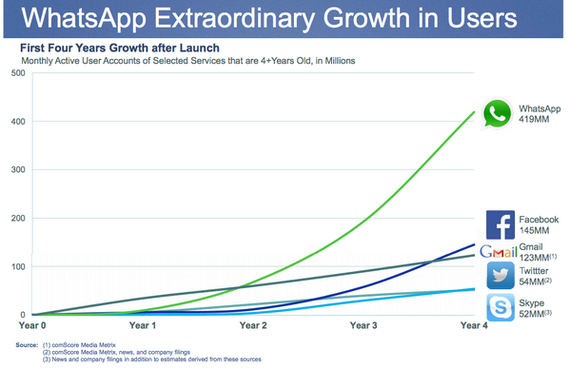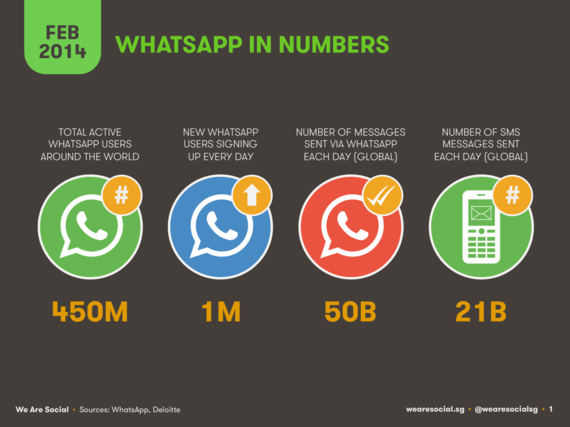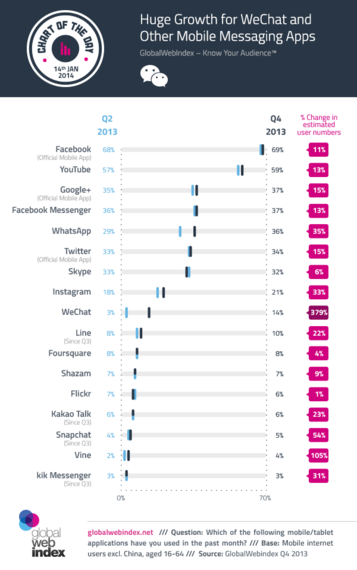Facebook's recent purchase of WhatsApp took many tech watchers by surprise; not least because of its eye-watering $19 billion price tag.
But after an initially sharp intake of breath, analysts and other tech giants appeared to endorse the move; citing the geographic spread of the service, it's message volumes and continued growth. Bill Gates, in an interview with Rolling Stone, said of the move:
"It means that Mark Zuckerberg wants Facebook to be the next Facebook. Mark has the credibility to say, "I'm going to spend $19 billion to buy something that has essentially no revenue model." I think his aggressiveness is wise - although the price is higher than I would have expected. It shows that user bases are extremely valuable."
And Facebook isn't the only mainstream tech company investing in this space. 2014 has also seen the Japanese Internet company Rakuten spend $900 million to acquire Viber - and China's Alibaba investing $215 million in another messaging app, Tango.
Given these sums - and interest in these types of services across the globe - it's no wonder that many tech observers are asking if social messaging apps are the next big thing.
Arguably, they already are.
Although initially seen by some users as simple SMS replacements; user engagement rates are increasing as the apps evolve and become "stickier" by incorporating opportunities for exclusive content, in-app purchases and in-app gaming.
You can find out more about the rapid growth of these networks in five key charts below; as well as read more about the characteristics associated with some of these individual networks in this presentation - 10 thing you need to know about Chat Apps - from ictQATAR.(Quick disclaimer: I work there.)
1.WhatsApp has enjoyed a rapid adoption curve...

Source: http://bit.ly/1hwLuEQ
2....And it is continuing to grow fast

Source: http://bit.ly/1lFrjtD
3.But WhatsApp isn't the only player in town...
Although WhatsApp's figures are impressive, the market contains a number of other players many of which dominate - but are not confined to - their country of origin.
Line remains dominant in Japan, WeChat in China and Kakao, is reported to be installed on over 90% of all South Korean smartphones. They're also seeing rapid growth.

Source: http://bit.ly/1gCmKuV
4....And users often harness multiple apps
Alongside using multiple apps to talk to their friends; app tracking company Onavo also found that American based users were also more likely to use other apps in the same language, or reflecting similar content.
US based users of KakaoTalk, for example, are much more likely to access other apps such as the East Asian media streaming service Crunchyroll and Viki, which shows popular Korean, Taiwanese and Japanese dramas.
Whilst Viber users - in line with the popularity of this service in India - are also popular users of apps like Raaga, which offers music in Hindi, Tamil and other languages popular on the sub-continent, and Athan; which provides Muslims with issues automatic calls to prayer at the correct time of day, five times a day.

Source: http://bit.ly/1h6RSYq
5.Usage lags behind established networks, but new services are growing fast
Data from GlobalWebIndex shows that over a six month period, services like Snapchat and Kik were growing quicker than more established mobile services. Instagram and Vine - both of which were snapped up by players in recent years (Facebook and Twitter respectively) - also performed well, perhaps offering a model for how tech giants can absorb and grow other mobile services, without stifling them.

Source: http://bit.ly/PR9VH1
